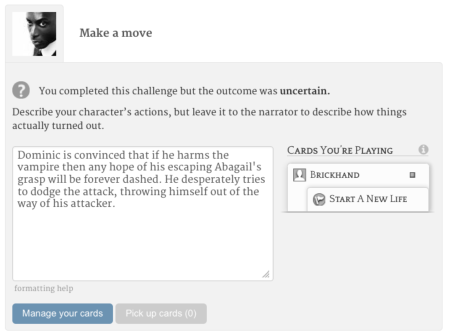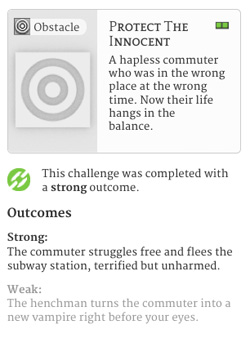Storium in a nutshell
This page covers the basics of Storium and provides a great overview for new players.
Online storytelling
 Watch a brief video overview of Storium
Watch a brief video overview of Storium
Storium is an online storytelling game, and that makes it different from most other games you’ve probably played. How so?
It turns writing into a game
In Storium you have the freedom to truly do anything that you can imagine. That’s because Storium is based around creative writing. As you play, the game helps you figure out what to write next and how to keep your story interesting.
Everyone gets a say
Storium lets every player share in the storytelling. Everyone gets their moment in the spotlight, their own chance to decide what happens next in the story.
Anyone can play
You don’t have to be a skilled writer to play Storium. The game gives you the kind of creative “leg up” that’s missing when you stare at a blank sheet of paper.
Host, Narrators, and Players
Each Storium game has a host. The host is the person who starts the game, invites others to join, and generally acts as organizer and moderator.
Each game also has a narrator. This can be the host, or it can be someone else. The narrator drives the game forward by starting scenes and laying out challenges for the other players to overcome in the story.
Everyone else in a Storium game is a player. Each player controls their own character. Players use their characters to overcome the challenges posed by the narrator.
Storium games can have either a single narrator (where one person plays that role for the entire game), or the narrator role can automatically rotate among the players, scene by scene (resulting in an even more collaborative experience). The choice is up to the host.
Storium plays best with 3-5 players (including the narrator), although you can have as many as you like.
Story cards
The key to playing Storium is story cards. They’re like virtual playing cards that represent different aspects of your story such as people, places and situations. You and your fellow players use these cards to set up interesting situations, describe the action, and move the story forward. You can think of story cards as writing prompts that inspire you with ideas and suggestions as you play.
Every Storium game has a deck of story cards. The host can create them from scratch, or they can choose one of Storium’s many “worlds,” each of which comes with its own deck. You and your fellow players can also create new cards on the fly, as you play!
Narrator cards
Narrators have three kinds of cards, which they use to establish each scene of the story and put forth challenges for the other players to overcome. Narrator cards are wide instead of tall.
Place
The locations where each scene unfolds in your story.
Character
People in the story who challenge the players or want something from them.
Obstacle
Anything else in the story that challenges or hinders the players.
Player cards
Players have six kinds of cards, which they use to create their characters, describe their actions in the story, and overcome the narrator’s challenges. Player cards are tall instead of wide.
Nature
A character’s background or origin.
Strength
A character’s traits or abilities that give them an edge.
Weakness
A character’s limitations or shortcomings that trip them up.
Subplot
A character’s central motivation — the thing that drives them.
Asset
Something unique or important that can be used to affect the story.
Goal
A task that a player can choose to take on, for a reward.
How games work
Scenes
Storium games unfold as a series of scenes, just like in a movie or a book. When starting a new scene, the narrator creates challenges by playing their own cards.

Challenges come in two forms. Character cards represent people who confront the players or want something from them. Obstacle cards represent anything else that gets in the players’ way.
Every challenge has a certain number of points. This is the number of cards that players need to play to overcome the challenge. More points means a tougher challenge.
Once the narrator has played their cards, they write a brief description of the situation, and the stage is set!
Moves
Now that the scene has started, the other players each make one or more moves. This means playing their own cards to show how their characters overcome the narrator's challenges.

Players get these cards when they create their characters, and they earn new ones in the course of play. The kind of card you play determines how things turn out in the story.
Strength and Weakness cards represent the abilities or shortcomings that set your character apart. You start with three of each, plus some cards that are “wild,” meaning that you can write them when you need them.
Players have other cards, too. Subplots describe a character's motivation — the thing that really drives them. Assets are valuable things or knowledge that give players an edge. And Goals are tasks or objectives that players can choose to take on for a reward.

Winning control of the story
Playing these cards helps overcome the narrator’s challenges, but it also earns you the chance to win control of the story. This means you can write how the challenge in question turns out, using “outcomes” written by the narrator as a guide.
Play enough Strength cards on a challenge and you can write about how it worked out in your favor. Play enough Weaknesses and you still get to narrate the outcome, but there will usually be some sort of interesting complication or setback to deal with. Playing Subplots, Assets, and Goals helps to complete the challenge but doesn’t tilt the outcome in one direction or another.
Advancing the story
Once all the scene’s challenges have been overcome, the scene is complete. The narrator can either end it and then start the next one, or they can choose to continue the scene by adding new challenges.
This flow of play ensures that every scene is interesting, helps to advance the story, and gives every player something to do and a chance to be a part of the storytelling!
